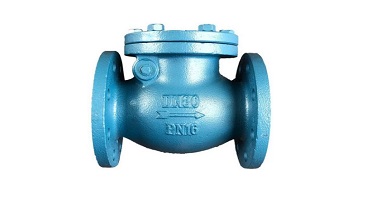Check valve
Check Valve
Check Valve material :
Cast Iron -20 to 410 degree
Ductile Iron -20 to 650 degree
Carbon Steel (Grade WCB) -20 to 1000
Carbon Steel (Grade LCB) -50 to 650
Carbon Moly (Grade WC1) -20 to 850
Type 304 (Grade CF 8) -425 to 1500
Type 347 (Grade CF8C) -425 to 1500
Type 316 (Grade CF8M) -425 to 1500
Aluminum -325 to 400
Bronze -325 to 550
Inconel 600 for -325 to 1200
Monel 400 for -325 to 900
Hastelloy B for -325 to 700
Hastelloy C for -325 to 1000
Titanium 600 Nickel for -325 to 500
Check valves are generally installed in pipelines to prevent backflow. A check valve is basically a one-way valve, in which the flow can run freely one way, but if the flow turns the valve will close to protect the piping, other valves, pumps etc.
Most common types of Check valves are:
swing :
In swing check valves, the disc is unguided once it moves to completely open position or to completely closed position. Many alternative disc and seat designs are accessible to satisfy needs of variable applications. Soft-seated– swing check valves give improved leak tightness compared to metal-to metal seating surfaces. Combination seats consisting of a metal seat ring with resilient insert additionally provide higher leak tight characteristics. The seating angle, the angle between the seat and therefore the vertical plane, might vary from zero to forty five degrees. Vertical seats have a zero angle. Larger seat angles cut back the disc travel, leading to fast closing, therefore minimizing the chance of loud
noise. Sometimes the seat angles are within the range of five to seven degrees.

lift (piston and ball) :
Lift check valves are significantly custom-made for high-pressure service wherever speed of flow is high. In lift check valves, the piston disc is accurately target-hunting by long contact and an in depth sliding work with the peerless targeted dash pot. The walls of the piston and dash pot are of roughly equal thickness. Giant steam jackets are placed outside of the dash pot and within the piston to eliminate sticking out due to differential enlargement. The seat ring is of a barrel sort design of significant uniform crosswise. It’s commonly screwed in and seal welded. The flow gap is full port size.
The seat design of a lift-check valve is comparable to a globe valve. The disc is typically within the type of a piston or a ball. The ball-lift check valves are employed in extremely viscous fluid service. These check valves have superior leak-tight feature to those of swing check valves.
The piston kind lift check valves have an inclination to stick within the open position once service fluid has sediment treed on top of the piston. Giant lift check valves are equipped an equalizer line between the chamber on top of the disc and therefore the downstream aspect of the valve.

tilting-disc check valve:
The tilting-disc check valve is intended to overcome a number of the weaknesses inherent in typical swing check valves. A mix of design options allows the valve to open absolutely and stay steady at lower flow velocities and to shut quickly upon stop of forward flow. The dome-shaped disc floats within the flow with fluid on each bottom and high of its surfaces, therefore its minimum dash pot impact. It performs well in pulsing, turbulent, and high-speed flows. These attributes prolong the valve’s lift and cut back flow-induced dynamic masses on the piping system.



- Description
- Comments
Standards for Check Valve:
To access standard for design check valve API 6D please click here
To access standard for check valve Body Material please click here
Two other types of Check Valves that are being used more often in transmission pipe lines:
Vertical or In-Line Check Valve
These valves are offered in 2 configurations: in-line ball check and totally guided disc with soft or hard seats. In-line ball check valves will be utilized in each vertical and horizontal line. The totally guided disc inline check valves should be supplied with a spring-assist closure once employed in horizontal lines. In vertical lines, the guided disc in-line check valves might or might not be supplied with spring-assist closure. The spring-assist closure not solely assists in closing the valve quickly; it minimizes the chance of loud .noise by preventing flow reversal. They can be utilized in applications having pulsing flows, like in a discharge line of a reciprocating compressor. As a result of their compact in size, they’re ideal for application in tight areas.

Stop Check Valve
A stop check valve will either be used as a one-way check valve or as an isolation (stop) valve sort of a gate or globe valve. Throughout traditional operation of a system, these valves are used as an everyday check valve; but, once required, these valves may be closed with the assistance of a screw-down stem that isn’t mounted to the valve disc. The stem, once totally screwed down, holds the free-floating disc against the valve seat, even as in a gate or a globe valve. These valves are accessible in tee-pattern, Wye-pattern, angle-pattern, and inclined pattern. The swing-and-piston lift-disc style check valves are normally used as stop check valves




